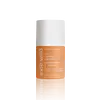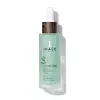What's inside
What's inside
 Key Ingredients
Key Ingredients

 Benefits
Benefits

 Concerns
Concerns

 Ingredients Side-by-side
Ingredients Side-by-side

Water
Skin Conditioning3-O-Ethyl Ascorbic Acid
Skin ConditioningPropanediol
SolventNiacinamide
SmoothingGlycerin
HumectantPolyglyceryl-6 Caprylate
EmulsifyingPolyglyceryl-10 Laurate
Skin ConditioningPolyglyceryl-4 Caprate
EmulsifyingTocopheryl Acetate
AntioxidantHydroxyacetophenone
AntioxidantBisabolol
MaskingFerulic Acid
AntimicrobialPolyglyceryl-10 Myristate
Skin ConditioningXanthan Gum
EmulsifyingCaprylyl Glycol
EmollientWithania Somnifera Root Extract
Skin ConditioningCurcuma Longa Root Extract
MaskingSclerotium Gum
Emulsion StabilisingLecithin
EmollientPullulan
Sorbitol
Humectant1,2-Hexanediol
Skin ConditioningSilica
AbrasivePhenoxyethanol
PreservativeBiosaccharide Gum-4
Skin ConditioningPentylene Glycol
Skin ConditioningSodium Hyaluronate
HumectantScenedesmus Rubescens Extract
Skin ConditioningAscorbic Acid
AntioxidantCI 77480
Cosmetic ColorantCitric Acid
BufferingGlutathione
Water, 3-O-Ethyl Ascorbic Acid, Propanediol, Niacinamide, Glycerin, Polyglyceryl-6 Caprylate, Polyglyceryl-10 Laurate, Polyglyceryl-4 Caprate, Tocopheryl Acetate, Hydroxyacetophenone, Bisabolol, Ferulic Acid, Polyglyceryl-10 Myristate, Xanthan Gum, Caprylyl Glycol, Withania Somnifera Root Extract, Curcuma Longa Root Extract, Sclerotium Gum, Lecithin, Pullulan, Sorbitol, 1,2-Hexanediol, Silica, Phenoxyethanol, Biosaccharide Gum-4, Pentylene Glycol, Sodium Hyaluronate, Scenedesmus Rubescens Extract, Ascorbic Acid, CI 77480, Citric Acid, Glutathione
Water
Skin ConditioningAloe Barbadensis Leaf Juice
Skin ConditioningGlycerin
HumectantPropanediol
SolventVitis Vinifera Fruit Water
Skin ConditioningPolysorbate 20
EmulsifyingPhenoxyethanol
PreservativeBeta Vulgaris Root Extract
Skin ConditioningCaprylyl Glycol
EmollientPolyacrylate Crosspolymer-6
Emulsion StabilisingHydroxyethyl Acrylate/Sodium Acryloyldimethyl Taurate Copolymer
Emulsion StabilisingCitrus Aurantium Dulcis Peel Oil
MaskingLimonene
PerfumingSodium Hyaluronate
HumectantAminomethyl Propanol
BufferingCopper PCA
HumectantEthylhexylglycerin
Skin ConditioningGlycine
BufferingNiacinamide
SmoothingLactic Acid
BufferingCitric Acid
BufferingPolysorbate 60
EmulsifyingSorbitan Isostearate
EmulsifyingArctium Lappa Root Extract
Skin ConditioningCalendula Officinalis Flower Extract
MaskingCamellia Sinensis Leaf Extract
AntimicrobialCitrus Nobilis Peel Oil
MaskingCitrus Paradisi Peel Oil
MaskingCurcuma Longa Root Extract
MaskingNelumbo Nucifera Flower Extract
Skin ConditioningTamarindus Indica Fruit Extract
Skin ConditioningTerminalia Ferdinandiana Fruit Extract
AntioxidantTrifolium Pratense Flower Extract
AstringentBiosaccharide Gum-1
HumectantHaberlea Rhodopensis Leaf Extract
Skin ConditioningYeast Extract
Skin ConditioningLevulinic Acid
PerfumingP-Anisic Acid
MaskingSodium Hydroxide
BufferingGlyceryl Caprylate
EmollientVanilla Planifolia Fruit Extract
Skin ConditioningTocopherol
AntioxidantPectin
Emulsion StabilisingWater, Aloe Barbadensis Leaf Juice, Glycerin, Propanediol, Vitis Vinifera Fruit Water, Polysorbate 20, Phenoxyethanol, Beta Vulgaris Root Extract, Caprylyl Glycol, Polyacrylate Crosspolymer-6, Hydroxyethyl Acrylate/Sodium Acryloyldimethyl Taurate Copolymer, Citrus Aurantium Dulcis Peel Oil, Limonene, Sodium Hyaluronate, Aminomethyl Propanol, Copper PCA, Ethylhexylglycerin, Glycine, Niacinamide, Lactic Acid, Citric Acid, Polysorbate 60, Sorbitan Isostearate, Arctium Lappa Root Extract, Calendula Officinalis Flower Extract, Camellia Sinensis Leaf Extract, Citrus Nobilis Peel Oil, Citrus Paradisi Peel Oil, Curcuma Longa Root Extract, Nelumbo Nucifera Flower Extract, Tamarindus Indica Fruit Extract, Terminalia Ferdinandiana Fruit Extract, Trifolium Pratense Flower Extract, Biosaccharide Gum-1, Haberlea Rhodopensis Leaf Extract, Yeast Extract, Levulinic Acid, P-Anisic Acid, Sodium Hydroxide, Glyceryl Caprylate, Vanilla Planifolia Fruit Extract, Tocopherol, Pectin
 Reviews
Reviews

Ingredients Explained
These ingredients are found in both products.
Ingredients higher up in an ingredient list are typically present in a larger amount.
Caprylyl Glycol is a humectant and emollient, meaning it attracts and preserves moisture.
It is a common ingredient in many products, especially those designed to hydrate skin. The primary benefits are retaining moisture, skin softening, and promoting a healthy skin barrier.
Though Caprylyl Glycol is an alcohol derived from fatty acids, it is not the kind that can dry out skin.
This ingredient is also used as a preservative to extend the life of products. It has slight antimicrobial properties.
Learn more about Caprylyl GlycolCitric Acid is an alpha hydroxy acid (AHA) naturally found in citrus fruits like oranges, lemons, and limes.
Like other AHAs, citric acid can exfoliate skin by breaking down the bonds that hold dead skin cells together. This helps reveal smoother and brighter skin underneath.
However, this exfoliating effect only happens at high concentrations (20%) which can be hard to find in cosmetic products.
Due to this, citric acid is usually included in small amounts as a pH adjuster. This helps keep products slightly more acidic and compatible with skin's natural pH.
In skincare formulas, citric acid can:
While it can provide some skin benefits, research shows lactic acid and glycolic acid are generally more effective and less irritating exfoliants.
Most citric acid used in skincare today is made by fermenting sugars (usually from molasses). This synthetic version is identical to the natural citrus form but easier to stabilize and use in formulations.
Read more about some other popular AHA's here:
Learn more about Citric AcidCurcuma Longa Root Extract is from the spice, turmeric. Besides being a healthy and delicious spice, turmeric also has plenty of skincare benefits. It has anti-inflammatory, antioxidant, and anti-microbial properties.
Turmeric contains curcumin, an antioxidant. Antioxidants help neutralize unstable free-radical molecules. Free-radical molecules may damage your skin's cells and DNA. Curcumin may help with anti-aging.
Curcumin also has anti-inflammatory properties and can help soothe skin and reduce irritation. On top of that, curcumin has been shown to help prevent hyperpigmentation from sun damage.
The anti-microbial property of turmeric can make it effective in treating acne. This property has also been shown to help regulate the production of sebum.
Learn more about Curcuma Longa Root ExtractGlycerin is already naturally found in your skin. It helps moisturize and protect your skin.
A study from 2016 found glycerin to be more effective as a humectant than AHAs and hyaluronic acid.
As a humectant, it helps the skin stay hydrated by pulling moisture to your skin. The low molecular weight of glycerin allows it to pull moisture into the deeper layers of your skin.
Hydrated skin improves your skin barrier; Your skin barrier helps protect against irritants and bacteria.
Glycerin has also been found to have antimicrobial and antiviral properties. Due to these properties, glycerin is often used in wound and burn treatments.
In cosmetics, glycerin is usually derived from plants such as soybean or palm. However, it can also be sourced from animals, such as tallow or animal fat.
This ingredient is organic, colorless, odorless, and non-toxic.
Glycerin is the name for this ingredient in American English. British English uses Glycerol/Glycerine.
Learn more about GlycerinNiacinamide is a multitasking form of vitamin B3 that strengthens the skin barrier, reduces pores and dark spots, regulates oil, and improves signs of aging.
And the best part? It's gentle and well-tolerated by most skin types, including sensitive and reactive skin.
You might have heard of "niacin flush", or the reddening of skin that causes itchiness. Niacinamide has not been found to cause this.
In very rare cases, some individuals may not be able to tolerate niacinamide at all or experience an allergic reaction to it.
If you are experiencing flaking, irritation, and dryness with this ingredient, be sure to double check all your products as this ingredient can be found in all categories of skincare.
When incorporating niacinamide into your routine, look out for concentration amounts. Typically, 5% niacinamide provides benefits such as fading dark spots. However, if you have sensitive skin, it is better to begin with a smaller concentration.
When you apply niacinamide to your skin, your body converts it into nicotinamide adenine dinucleotide (NAD). NAD is an essential coenzyme that is already found in your cells as "fuel" and powers countless biological processes.
In your skin, NAD helps repair cell damage, produce new healthy cells, support collagen production, strengthen the skin barrier, and fight environmental stressors (like UV and pollution).
Our natural NAD levels start to decline with age, leading to slower skin repair, visible aging, and a weaker skin barrier. By providing your skin niacinamide, you're recharging your skin's NAD levels. This leads to stronger, healthier, and younger looking skin.
Another name for vitamin B3 is nicotinamide. This vitamin is water-soluble and our bodies don't store it. We obtain Vitamin B3 from either food or skincare. Meat, fish, wheat, yeast, and leafy greens contain vitamin B3.
The type of niacinamide used in skincare is synthetically created.
Learn more about NiacinamidePhenoxyethanol is a preservative that has germicide, antimicrobial, and aromatic properties. Studies show that phenoxyethanol can prevent microbial growth. By itself, it has a scent that is similar to that of a rose.
It's often used in formulations along with Caprylyl Glycol to preserve the shelf life of products.
Propanediol is an all-star ingredient. It softens, hydrates, and smooths the skin.
It’s often used to:
Propanediol is not likely to cause sensitivity and considered safe to use. It is derived from corn or petroleum with a clear color and no scent.
Learn more about PropanediolSodium Hyaluronate is hyaluronic acid's salt form. It is commonly derived from the sodium salt of hyaluronic acid.
Like hyaluronic acid, it is great at holding water and acts as a humectant. This makes it a great skin hydrating ingredient.
Sodium Hyaluronate is naturally occurring in our bodies and is mostly found in eye fluid and joints.
These are some other common types of Hyaluronic Acid:
Learn more about Sodium HyaluronateWater. It's the most common cosmetic ingredient of all. You'll usually see it at the top of ingredient lists, meaning that it makes up the largest part of the product.
So why is it so popular? Water most often acts as a solvent - this means that it helps dissolve other ingredients into the formulation.
You'll also recognize water as that liquid we all need to stay alive. If you see this, drink a glass of water. Stay hydrated!
Learn more about Water